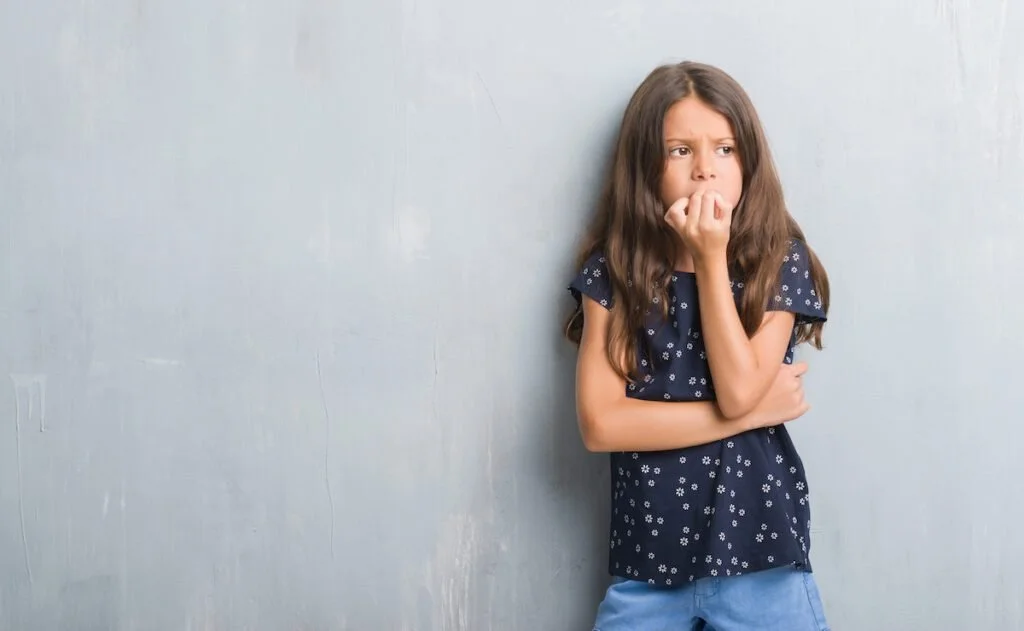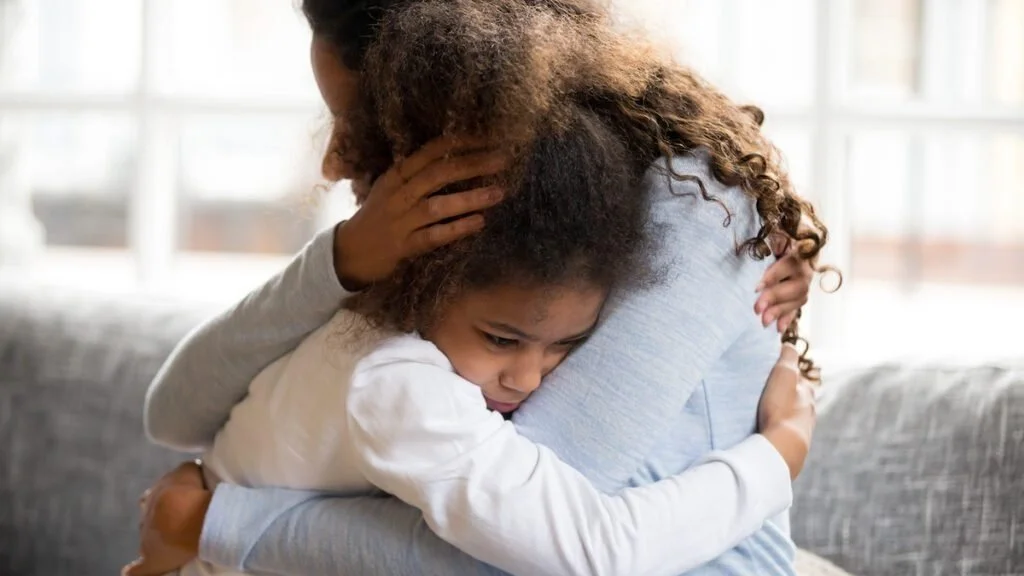How to parent an anxious kid (the stuff you need to know)
Understanding the difference between a small childlike fear and something that falls into the realm of ‘anxiety’ can be really tough to navigate as a parent. Trust me, I know all about it. Ever had a child petrified of falling asleep in the dark? Refusing to go to sports day? Or one that freaks out over the tiniest bit of fruit on their plate?
By Lynn Jenkins, Clinical Child Psychologist and Hypnotherapist at Life Matters
Yup…child anxiety comes in all sounds, shapes and sizes and can surreptitiously make a mark on the whole family. You’re not alone in this parenting struggle and let me tell you, there is a way to get through it. It just takes a little knowledge, tools, time and practice.
Let’s start with the knowledge…
What is child anxiety?
As our brains start to develop, the first powerful part that begins to form is called the survival brain. If our survival brain had its own protest chant, it would go something like this…Protect! Protect! Protect! The ONLY priority of this major part of our body is to keep us safe, and it is always on duty.
Children experience anxiety for many reasons (a list of a few common ones below). It’s the awful feelings of anxiety that are actually a product of our body working to keep us safe. Isn’t that kind of cool? So, we could rephrase ‘children experience anxiety for many reasons’ to children’s bodies have many reasons to keep them safe.
As parents, while it’s easy to jump straight to naming and labelling, it’s important to see our kids’ anxiety through this new ‘lens’ as, quite simply, this is all anxiety is. If we understand the threat, we can understand the anxiety. I know as a parent this can be a tricky exercise!
Common reasons children experience anxiety
The dark
Dogs
Insects
Storms
Vomiting
Monsters
Robbers
Being away from parents
Common forms of child anxiety
Kids’ anxiety comes in many forms, some rather simple, and others a lot more complicated. Here are some of the more common forms of anxiety.
Generalised Anxiety
Separation Anxiety
Food Anxiety
Specific Phobias
Obsessions and Compulsions
While anxieties differ in the way they manifest and present, they all have the ‘mechanism’ in common. This enables us as parents with an opportunity to work with our kids to understand their experience and help them to manage it.
Why does anxiety happen?
Anxiety is the product of a ‘thought story’ that is scary to that particular child. For example, lightening is going to strike me! That dog is going to bite me! That shape in the dark is a monster!
The scary thought story goes directly to a part in our brains called the amygdala. In this moment, the amygdala only has two choices to react: safe or unsafe. Because the story is scary, the amygdala decides the child is unsafe and so the protection system switches on. The ways our body protects us is preparing it to fight the ‘danger’, flee the ‘danger’, or shutdown from the ‘danger’. In your child, this might look like yelling, kicking, throwing, running away, hiding, or being very quiet, but with a bit of a deer-in-headlights look on their little face.
The BIG thing parents need to know about child anxiety
When s**t hits the fan, parents can often jump to fixing situations when they are spiralling out of control – I can say this because I’m a culprit. It’s our protection system that is also clinging to fighting or fleeing danger which is why we make rash choices when what we really need is a considered response.
The What
If we can understand what is actually happening in our kid’s bodies when they are anxious, we can help them in a much more proactive way.
The Why
First, we need to pause and understand why their protection system is operating and governing their behaviours. The one, and only reason why their protection system is on, is because they perceive they are around threat or danger.
The How
This then gives us a clue towards how to help them. If I were to ask you: how would you treat your child if he/she was scared? What would you say? Maybe comfort them in some way? Yep! Bang on.
Before trying to help your child, their nervous system needs to be calm. BUT, in order for the nervous system to feel calm, the amygdala needs the ‘safe’ message to be sent its way. Plus, the main way humans feel safe is connection with another safe human and this is especially true for kids and it is more connection with their current experience that is needed at the time.
So, what do you need to do? You need to help your child feel safe and calm in a way that makes sense to them before trying to throw any fix-it phrases their way.
Something useful to keep in mind during this experience is that when kids (and all humans) are in protection mode, they are influenced by hard-wiring to look out for the ‘danger’, the ‘threat’, which means it is much, much easier to stay in protection mode; it takes a minute and quite a bit of convincing for the nervous system to accept they are safe in this state.
How to help your anxious child
Step 1: See their anxiety through the lens of their protection system
This means taking a step back, pausing and understanding that they are currently perceiving a danger/threat and that they feel scared.
Step 2: Help them to feel safe by communicating welcome not warning
Utilise your built-in ‘connector tool’, your Social Engagement System (SES) to do this. That is, your eyes, face, voice and posture.
Welcome = gentle voice, facial expression, eyes, posture, less words, no teaching, lecturing;
Warning = harsh voice, facial expression, eyes, posture, lots of words, trying to teach.
Anxious moments are simply NOT the time for warning, they are only a time for welcome. Warning communication will without doubt be interpreted as a threat to the amygdala and protection will continue, so choose welcome every time.
Step 3: Remember, you have the ONLY thing your child needs to move through an anxious moment
That thing is your SES, your ability to communicate welcome (safety).
When your kid feels safe…
They are placed in their calm zone….
Only then, they can then use the strategies they might have been taught to move forward with whatever it is they are doing at the time
Remember:
I tend to say a lot to parents, when you understand how the system works, we you work it.
Knowing what anxiety actually is – the protection zone – can help us understand why they are behaving the ways they are.
Knowing why that protection is on (only because our kids feel unsafe) helps us to know how to approach them as a first step (i.e., guide them to genuinely feel safe).
Knowing that they will feel genuinely safe when we communicate welcome helps us to know what to do (aka use our SES) to get them through the anxious moment.
Let me assure you, knowing what is happening and why your child is feeling fearful, scared or overwhelmed, will help you see your child’s anxiety in a totally new way.
So, like our nervous system has the chant Protect! Protect! Protect!, as parents, we can share its sentiment. The difference though, is that our meaning of ‘protect’ includes us playing a huge part in protecting our little beloveds’ emotional development by knowing what is going on in their anxious moments and therefore modeling the ideal way to approach it.
Further reading
Life Matters Disclaimer
All content in our article is published for informational purposes only. It is not intended to be a substitute for professional psychological advice and should not be relied on as personal advice. Always seek the guidance of a qualified psychologist with any questions you may have regarding your mental health.



